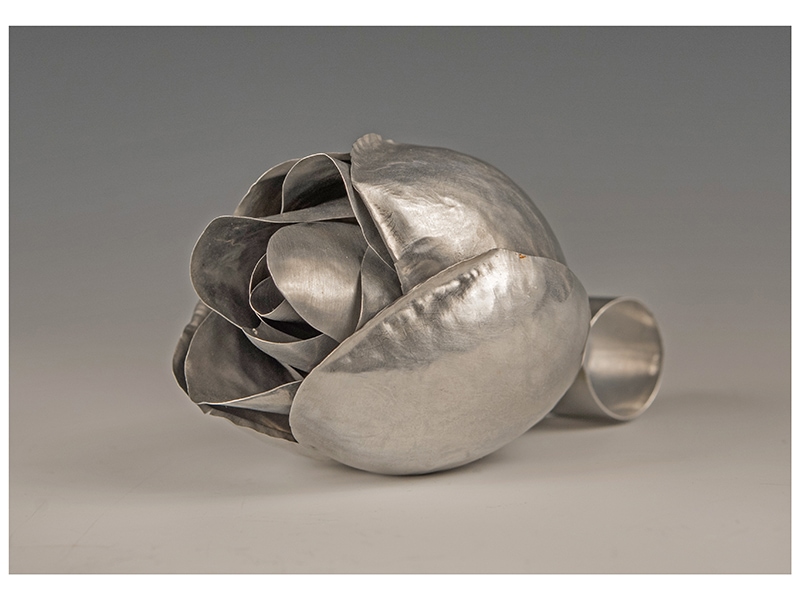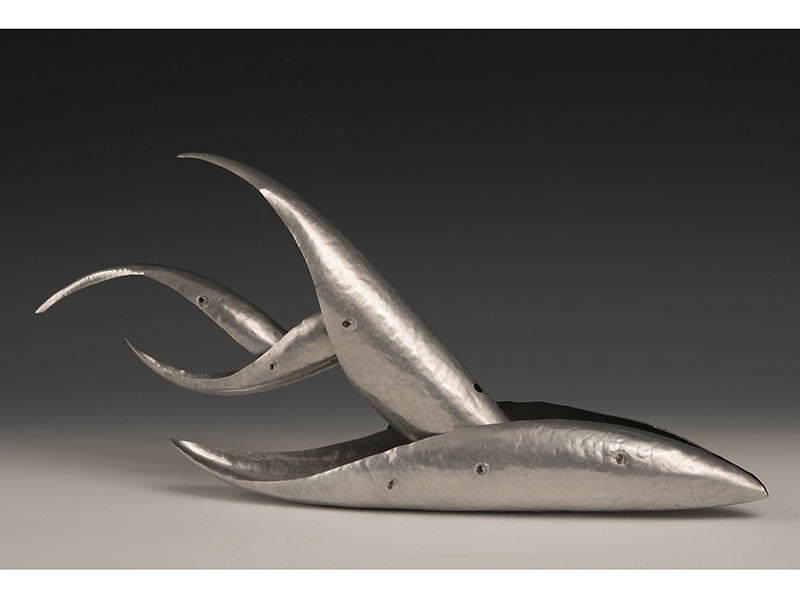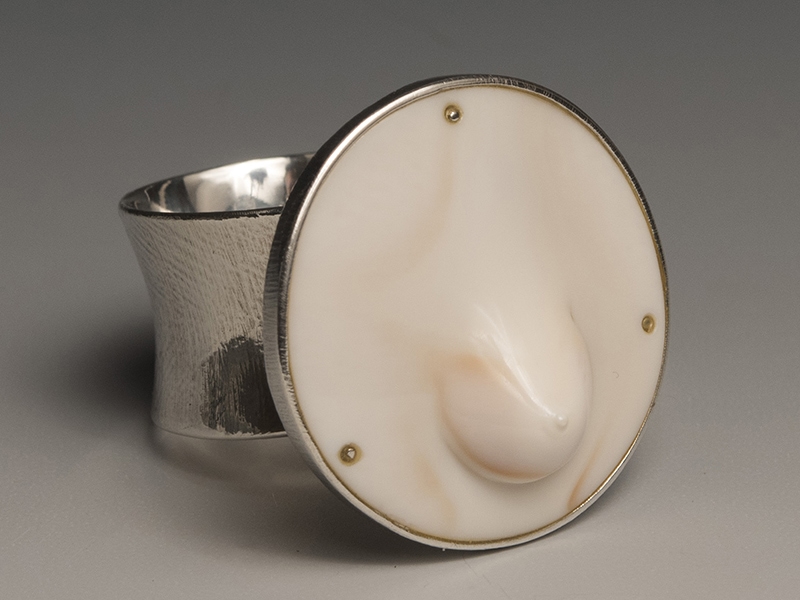Shinji Nakaba/ UBUI (First Time)
November 6–December 31, 2021
Gallery Loupe, Montclair, NJ, US
The historical, the erotic, and the overlooked only begin to describe the jewelry of the unconventional Japanese jeweler Shinji Nakaba (b. 1950). The artist was virtually unknown in the West until 2001, when his work began to achieve wider recognition.[1] As a self-described member of the counterculture since the 1970s, Nakaba has always felt most comfortable on the periphery. There, he was free to experiment with costume, shoes, and even hair designs, as well as his métier, jewelry.
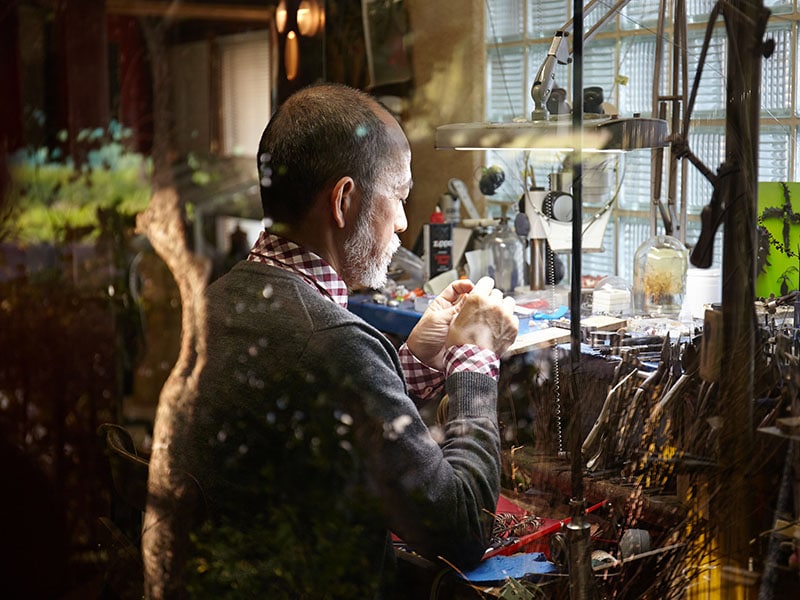
Nakaba developed a jewelry practice after a rudimentary technical introduction in the mid-1970s, when he was about 24 years old. Despite having spent his career outside of the collective comfort of the academy, his deeply personal aesthetic has won him thousands of devoted fans on social media and at international exhibitions. I recently viewed Shinji Nakaba/ UBUI (First Time), featuring works of art made over the last 15 years, at Gallery Loupe. (A portion of the show was also seen at The Jewelry Library during NYCJW21.)

Pearls have been the focus of Nakaba’s recent work. As is typical for him, he has gone against tradition by carving impossibly tiny forms into the iridescent surface. The artist prefers freshwater and keshi pearls for this purpose. He uses their naturally irregular forms as a means of inspiration. Each intricate carving relates to the human body, rendered as disembodied elements, some of which pack a small erotic charge. They include buttocks, breasts, lips, eyes, and hands, among others. The artist also created intriguing fingers made of multiple pearls bound together and carved into an index finger with a slightly angled, probing tip. Skulls, however, have been the most common and popular of all.
Calling them “fairy skulls,” Nakaba has made these tiny, intricately carved skulls into pendants, necklaces, and long, elegant brooches. Others appear in rings created by wrapping flat and rounded wire into delicate knots and bows. Naturally, no two are alike.
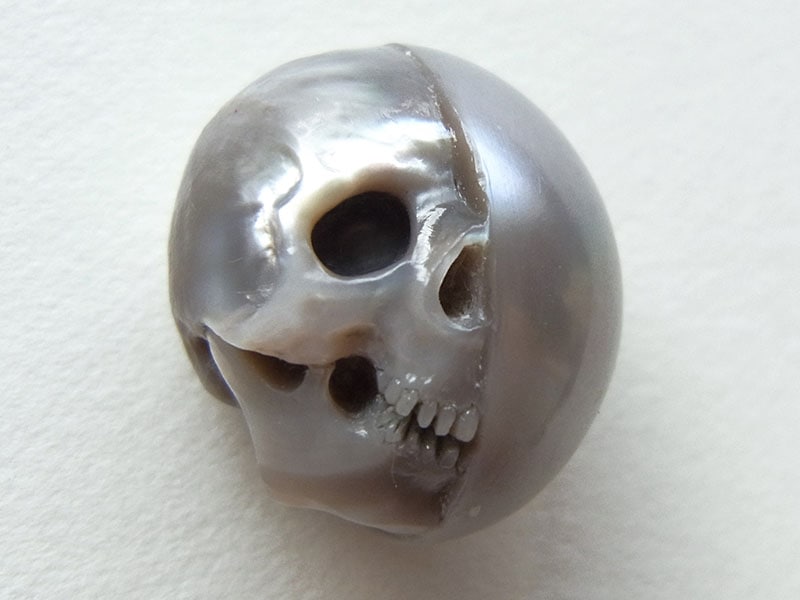
Skulls have been used around the world as a symbol of memento mori. The Latin term reminds us that we all eventually will die. In the West, they have been set into in rings. In the East, Tibetan monks used prayer beads made of tiny carved skulls to contemplate the meaning of life and death.
With their luminous surfaces and intricate details, Nakaba’s skulls exist in an iridescent, twilight world where one can move back and forth between the living and the dead. In sharing his own thoughts on this subject, the artist found “the contradiction between pristine pearls turning into these dark objects … even more appealing.”[2]
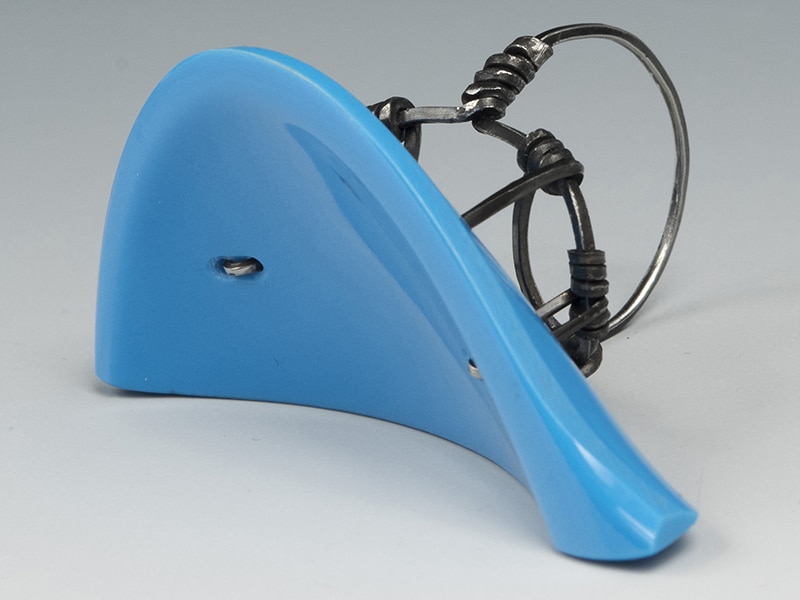
Pearls are but a small part of Nakaba’s practice. Materials interest him less for their value than for their potential application. For this reason, he enjoys making use of such overlooked items as a piece of blue plastic cut from an IKEA salad server, for instance, instead of the gemstones that typically adorn rings. In one example, the artist inverted the traditional method of marking jewelry by crudely adding his name and date on the front of the plastic. It is in plain view of wearer and viewer rather than in the back or underneath, as expected. Regarding the latter, I can appreciate the sentiment, but the execution left me cold. In another case, he flips the paradigm yet again with a ring made of gray PVC pipe and set with an amethyst.
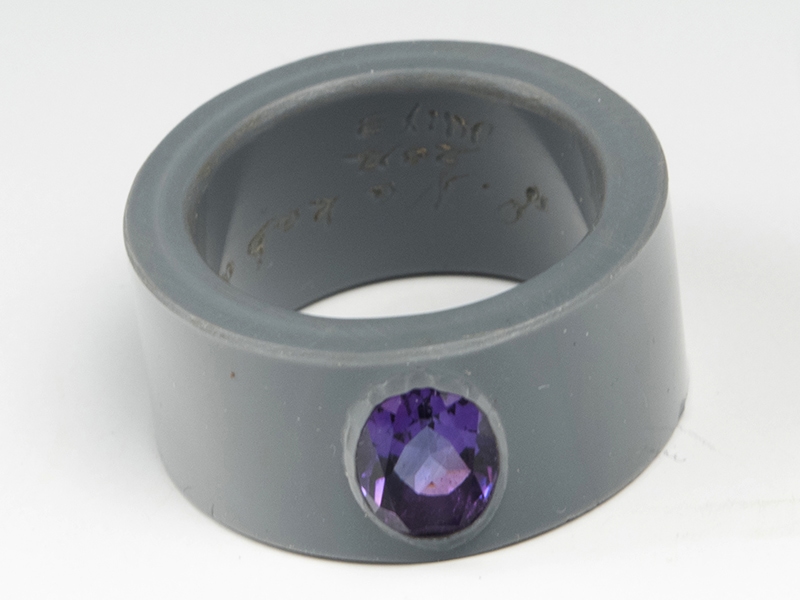
In another instance of his work with unconventional materials, aluminum cans allowed Nakaba to create works of unusual size and scale. From where we sit today, it is hard to believe that aluminum was considered a precious metal in the 19th century. Aluminum jewelry then was both rare and expensive. Fast forward to the 20th century, when technological advances transformed the material into a common industrial substance with little intrinsic value.
Costly or not, aluminum as a material remains unchanged, and Nakaba helps us see it afresh. In his expert hands, an ordinary, inexpensive Budweiser beer can transforms into budding leaves, flowers, and decadent, full-blown roses, as well as enormous, graduated, linked chains. All bear the softly winking, subtly hammered surface typically found on silver. They are as light as a feather.

The artist’s preference for small-scale objects such as pearls is also evident in his remarkable shell carvings. This art form was popular in Europe during the 18th and 19th centuries. As with the pearls, the subject matter is often suggested by the shape of the shell. Nakaba says that he has “always been in love with the ancient sculptures and antique jewelry displayed in museums, but … never 100% immersed in them. I’m not interested in re-creating the past as it was, I’m only satisfied with the work of an artist who lives in the 21st century.”
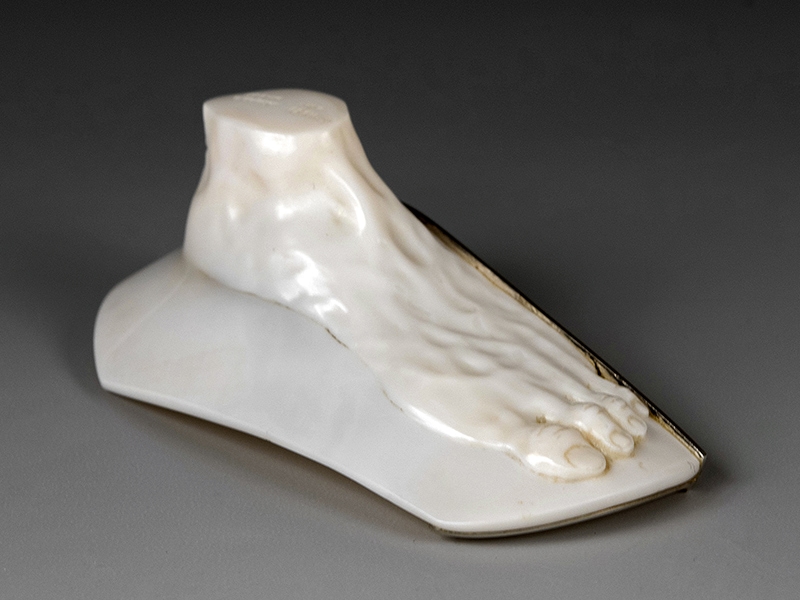
His shell carvings prove out this point of view. He has meticulously rendered body fragments or portraits. They superficially resemble statuary, broken and otherwise, associated with ancient Rome or Greece. Yet there is more to this than classical carvings. One example features a foot resting on a base, its ankle roughly severed. Nakaba’s 21st-century treatment of the foot is evident upon closer inspection. Pulsing veins and bones under a thin veil of flesh suggest a living, breathing—rather than sculptural—inspiration. In fact, it is the artist’s own foot, according to its title, My Left Foot. In another example, a disembodied breast floats against a flat expanse of shell. It is not a true fragment, but one that suggests a study or perhaps a personal recollection or memento.
Others shell carvings display an uncanny, ethereal quality despite their historical veneer. An example is Peace (2011). Yvonne Markowitz, the Rita J. Kaplan and Susan B. Kaplan Curator of Jewelry, Emerita, acquired it for the Museum of Fine Arts, Boston.[3] A head—neither male nor female—its eyes partially closed, appears to be in deep thought. Meanwhile, a length of molding runs up one side. Markowitz calls it “a captivating and often haunting, otherworldly carving.”[4]
Nakaba’s wirework is especially appealing. His constructions reveal long study of historic jewelry and metalwork, with solutions as distinctive as his intentions.
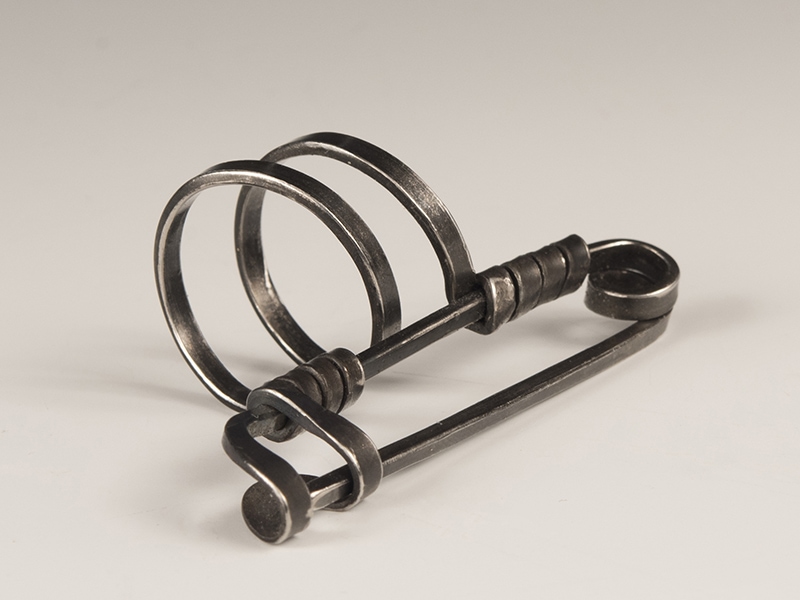
Take, for instance, his Ikebana rings. First of all, they are made of forged stainless steel, a material more suitable for making kitchen implements or car parts than jewelry. Its hardness requires a completely different set of tools than those used by jewelers working in silver or gold. Then there is their function, which is to provide a setting for live flowers. Yet ikebana, the art of Japanese flower arranging, is intended for vases, not fingers. The true delight of experiencing jewelry by Nakaba lies in the way he has subverted expectations in pursuit of a new experience.
Other examples made with steel wire, a similarly hard material, feature meandering S- and C-shaped curves. Based in 17th-century rococo designs, this decorative device generally plays a supporting role in ornamenting all kinds of decorative and printed arts, as well as edges, corners, railings, and the like. Inverting their traditional role, Nakaba makes these shapes central to his designs. He puts them to use as functional works, including as neckpieces, brooches, and earrings. His G-String wins the prize for most unexpected object in this series.
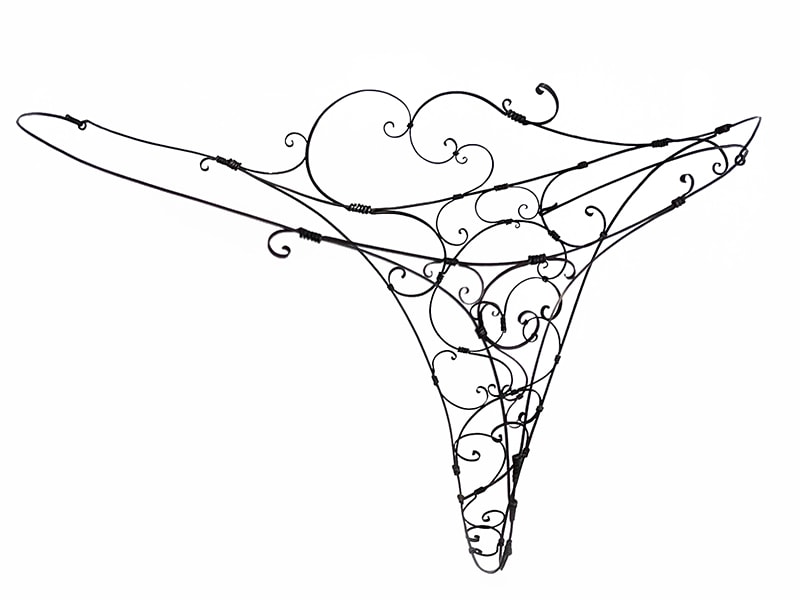
The exhibition includes a lively collection of colorful scarab beetles, ants, and other members of the insect world, fashioned by the artist and his son, Moto. The bodies are solid and made of polypropylene, as are their realistic, flexible legs. Recommended for the child in all of us.
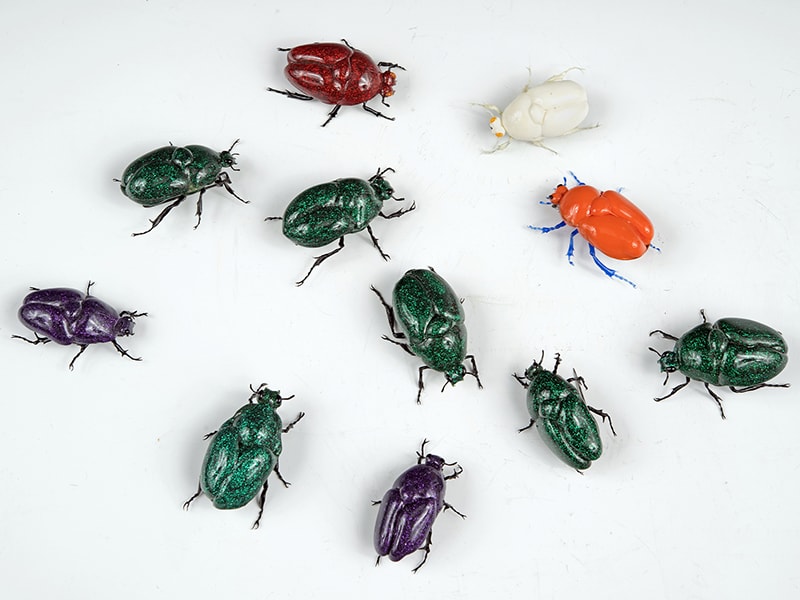
[1] The artist’s first US exhibition took place in 2001 at Julie Artisans’ Gallery, according to his website, http://work.s-nakaba.com/?pid=1. For the tale of Nakaba’s first visit to the gallery, where he was met by Toni Greenbaum, who then worked for the gallery, see her essay, “Disembodied Meaning: The Jewelry of Shinji Nakaba,” in Gallery Loupe’s catalog for Shinji Nakaba, Ubui (First Time), https://issuu.com/pattibleicher/docs/ubui_first_time_shinji_nakaba?mode=window.
[2] “Shinji Nakaba,” interviewed by Alyssa Shapiro, translated by Rika Noda, Whisper Editions, April 7, 2016, https://whispereditions.com/blog/shinji_nakaba_interview_by_alyssa_shapiro_translated_by_rika_noda.
[3] https://collections.mfa.org/objects/612792.
[4] Telephone conversation with Yvonne Markowitz, January 10, 2022.
